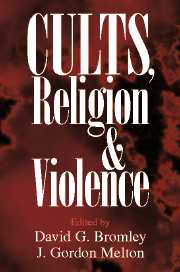Book contents
- Frontmatter
- Contents
- Acknowledgments
- Contributors
- Prologue
- 1 Violence and Religion in Perspective
- 2 Dramatic Denouements
- 3 Challenging Misconceptions about the New Religions–Violence Connection
- 4 Sources of Volatility in Religious Movements
- 5 Crises of Charismatic Legitimacy and Violent Behavior in New Religious Movements
- 6 Public Agency Involvement in Government–Religious Movement Confrontations
- 7 Watching for Violence: A Comparative Analysis of the Roles of Five Types of Cult-Watching Groups
- 8 Mass Suicide and the Branch Davidians
- 9 Occult Masters and the Temple of Doom: The Fiery End of the Solar Temple
- 10 Dramatic Confrontations: Aum Shinrikyô against the World
- 11 Making Sense of the Heaven's Gate Suicides
- 12 Lessons from the Past, Perspective for the Future
- Index
- References
2 - Dramatic Denouements
Published online by Cambridge University Press: 09 July 2009
- Frontmatter
- Contents
- Acknowledgments
- Contributors
- Prologue
- 1 Violence and Religion in Perspective
- 2 Dramatic Denouements
- 3 Challenging Misconceptions about the New Religions–Violence Connection
- 4 Sources of Volatility in Religious Movements
- 5 Crises of Charismatic Legitimacy and Violent Behavior in New Religious Movements
- 6 Public Agency Involvement in Government–Religious Movement Confrontations
- 7 Watching for Violence: A Comparative Analysis of the Roles of Five Types of Cult-Watching Groups
- 8 Mass Suicide and the Branch Davidians
- 9 Occult Masters and the Temple of Doom: The Fiery End of the Solar Temple
- 10 Dramatic Confrontations: Aum Shinrikyô against the World
- 11 Making Sense of the Heaven's Gate Suicides
- 12 Lessons from the Past, Perspective for the Future
- Index
- References
Summary
The objective of this volume is to develop a sociological explanation of what I term “Dramatic Denouements.” Dramatic Denouements transpire when a movement and some segment of the social order reach a juncture at which one or both conclude that the requisite conditions for maintaining their core identity and collective existence are being subverted and that such circumstances are intolerable. These relational moments are most likely to occur when the relationship between movement and society is characterized by polarization and destabilization. Parties on one or both sides thereupon undertake a project of final reckoning under the aegis of a transcendent mandate to reverse their power positions and to restore what they avow to be the appropriate moral order. This project is holistic in the sense that it is undertaken by the entire movement or social order or, alternatively, some segment thereof that acts in the name of the larger whole. Several definitions and assumptions are necessary to extend and clarify this argument.
First, the argument is historically grounded. The cases that are the focus of analysis here occurred in a specific historical context. Although parallels with other historical moments can plausibly be developed, the combination of social factors and their interactive dynamics would certainly vary in important ways.
- Type
- Chapter
- Information
- Cults, Religion, and Violence , pp. 11 - 41Publisher: Cambridge University PressPrint publication year: 2002
References
- 13
- Cited by

